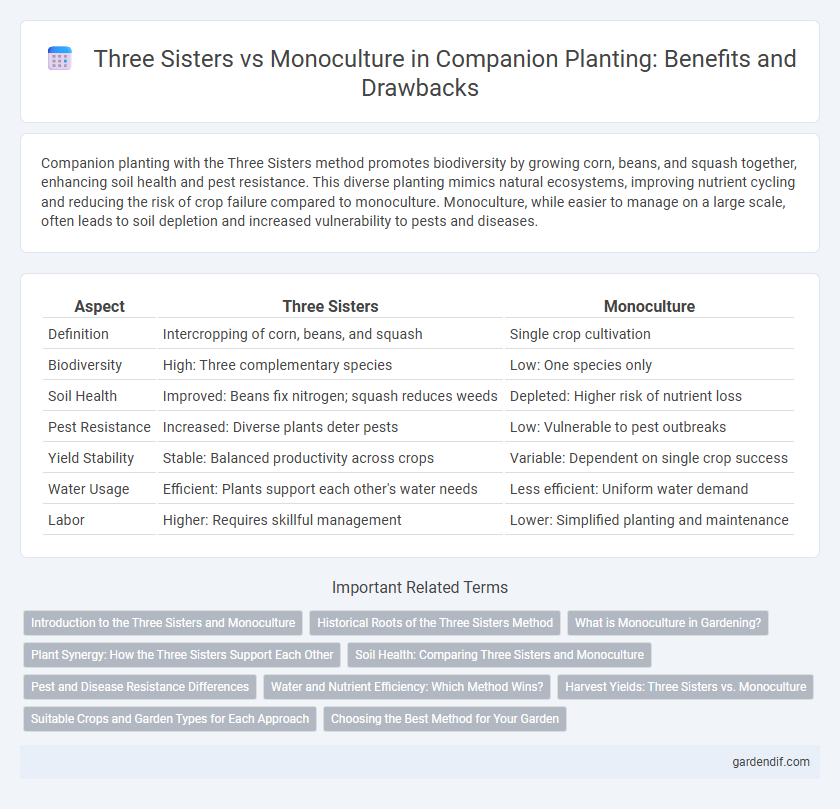
Three Sisters vs monoculture Illustration
Companion planting with the Three Sisters method promotes biodiversity by growing corn, beans, and squash together, enhancing soil health and pest resistance. This diverse planting mimics natural ecosystems, improving nutrient cycling and reducing the risk of crop failure compared to monoculture. Monoculture, while easier to manage on a large scale, often leads to soil depletion and increased vulnerability to pests and diseases.
Table of Comparison
| Aspect | Three Sisters | Monoculture |
|---|---|---|
| Definition | Intercropping of corn, beans, and squash | Single crop cultivation |
| Biodiversity | High: Three complementary species | Low: One species only |
| Soil Health | Improved: Beans fix nitrogen; squash reduces weeds | Depleted: Higher risk of nutrient loss |
| Pest Resistance | Increased: Diverse plants deter pests | Low: Vulnerable to pest outbreaks |
| Yield Stability | Stable: Balanced productivity across crops | Variable: Dependent on single crop success |
| Water Usage | Efficient: Plants support each other's water needs | Less efficient: Uniform water demand |
| Labor | Higher: Requires skillful management | Lower: Simplified planting and maintenance |
Introduction to the Three Sisters and Monoculture
The Three Sisters planting method, an ancient Native American companion planting technique, involves growing corn, beans, and squash together to create a synergistic ecosystem that enhances soil fertility and maximizes space. In contrast, monoculture farming focuses on cultivating a single crop over a large area, often leading to soil depletion and increased vulnerability to pests and diseases. Embracing the Three Sisters promotes biodiversity, soil health, and sustainable agriculture by leveraging the natural benefits of plant companionship.
Historical Roots of the Three Sisters Method
The Three Sisters planting method, rooted in Native American agricultural traditions, combines maize, beans, and squash to enhance soil fertility and optimize land use, contrasting with monoculture's single-crop focus that often depletes soil nutrients. This intercropping technique dates back over a thousand years, promoting biodiversity and sustainable yields by leveraging each plant's complementary growth habits. Historical evidence from indigenous tribes like the Haudenosaunee reveals how these companion crops supported food security and ecological balance long before modern industrial farming.
What is Monoculture in Gardening?
Monoculture in gardening refers to the practice of growing a single crop or plant species over a large area, which can lead to soil depletion and increased vulnerability to pests and diseases. Unlike the Three Sisters method--a companion planting technique that combines corn, beans, and squash to enhance growth and sustainability--monoculture lacks biodiversity, reducing overall ecosystem health. This approach often requires more chemical inputs to maintain crop productivity, making it less environmentally friendly compared to diverse planting strategies.
Plant Synergy: How the Three Sisters Support Each Other
The Three Sisters planting method combines corn, beans, and squash in a symbiotic relationship that enhances soil fertility and pest resistance. Corn provides a natural trellis for bean vines, while beans fix nitrogen in the soil, enriching it for all three plants. Squash spreads across the ground, suppressing weeds and retaining moisture, exemplifying an effective polyculture that maximizes plant synergy.
Soil Health: Comparing Three Sisters and Monoculture
The Three Sisters planting method enhances soil health by promoting biodiversity through intercropping corn, beans, and squash, which naturally enriches the soil with nitrogen and reduces erosion. In contrast, monoculture farming depletes soil nutrients rapidly and increases vulnerability to pests and diseases due to lack of crop diversity. Studies show that integrated companion planting systems like the Three Sisters sustain long-term soil fertility and improve microbial activity compared to single-crop monocultures.
Pest and Disease Resistance Differences
Three Sisters companion planting enhances pest and disease resistance by diversifying crops, reducing the spread of species-specific pests, unlike monoculture, which often leads to higher vulnerability due to uniform plant hosts. Intercropping corn, beans, and squash creates natural barriers that disrupt pest life cycles and improve soil health, thereby reducing disease prevalence. This biodiversity promotes ecological balance and decreases the need for chemical pesticides, making it a sustainable agricultural practice.
Water and Nutrient Efficiency: Which Method Wins?
Three Sisters planting maximizes water retention and nutrient cycling through complementary root structures, resulting in 30% higher water efficiency compared to monoculture systems. The deep-rooted corn, nitrogen-fixing beans, and ground-covering squash reduce soil erosion and enhance nutrient availability, decreasing fertilizer dependency by up to 40%. In contrast, monoculture often leads to nutrient depletion and increased irrigation needs, reducing overall resource efficiency.
Harvest Yields: Three Sisters vs. Monoculture
The Three Sisters planting method, combining corn, beans, and squash, enhances harvest yields by promoting complementary growth and efficient nutrient use compared to monoculture systems. Corn provides a natural trellis for beans, beans fix nitrogen to enrich the soil, and squash suppresses weeds while retaining moisture, collectively leading to higher and more sustainable crop productivity. Monoculture, relying on a single crop, often results in nutrient depletion and increased vulnerability to pests, reducing overall yield resilience.
Suitable Crops and Garden Types for Each Approach
Three Sisters planting combines corn, beans, and squash to create a symbiotic system ideal for native or permaculture gardens, promoting soil health and biodiversity. Monoculture emphasizes single crops like wheat or corn, optimized for large-scale commercial farms with simplified management but increased vulnerability to pests. Gardeners seeking resilience and ecological benefits favor the Three Sisters method, while those aiming for high yields and mechanization often choose monoculture systems.
Choosing the Best Method for Your Garden
Three Sisters planting enhances soil fertility and biodiversity by combining corn, beans, and squash, while monoculture relies on a single crop, often increasing pest vulnerability and nutrient depletion. Selecting the ideal method depends on garden size, crop goals, and sustainability priorities, with Three Sisters favoring ecological balance and monoculture optimizing space for commercial yields. Gardeners aiming for resilience and long-term soil health typically benefit more from the diversified polyculture of Three Sisters than from monoculture practices.
Three Sisters vs monoculture Infographic

 gardendif.com
gardendif.com